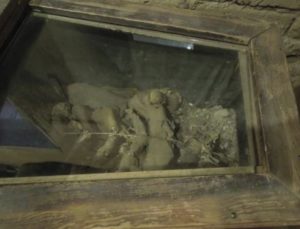
Last week when I was in Santa Fe, New Mexico and had a dickens of a time locating the Oldest House that I blogged about on Tuesday. According to the map and online guides, the Oldest House was said to be NEXT TO the Church. All I saw next to the Church was a pizza restaurant.
The church was locked so I tried to follow the sign on the government building next door that said “Visitor Info.” The sign had an arrow directing visitors to enter on the east or south entrance. I walked down the street in the direction the sign had pointed. There was no entrance on the street side so I suppose it was the north or west side. I turned at the intersection and again saw no entrance. Okay, I was certain to find the way in when I reached the back. I walked the entire length of the back side and still found no entrance. Turning left, I finally located the door. So what the sign meant was that there was one entrance and it was on the south east side.
I asked the attendant for directions to the Oldest Home. She said, “It’s BETWEEN the church and the restaurant.” I mentioned that a street was between the restaurant and the church. She insisted the home was BETWEEN and told me to look again.
I walked back to the church and again saw the restaurant in front of me as the church sits back from the street. I turned right to walk down the street BETWEEN the restaurant and the church and lo and behold, there was the Oldest House.
If I was to describe where the house was located, I would say it was BEHIND the restaurant and ACROSS the street from the church. This reminds me how careful we must be when we’re reading old deeds.
My people are famous for recording deeds noting boundaries of big rocks and tree stumps. I now wonder how many noted BETWEEN when I would have considered it BEHIND or south and east as southeast?

